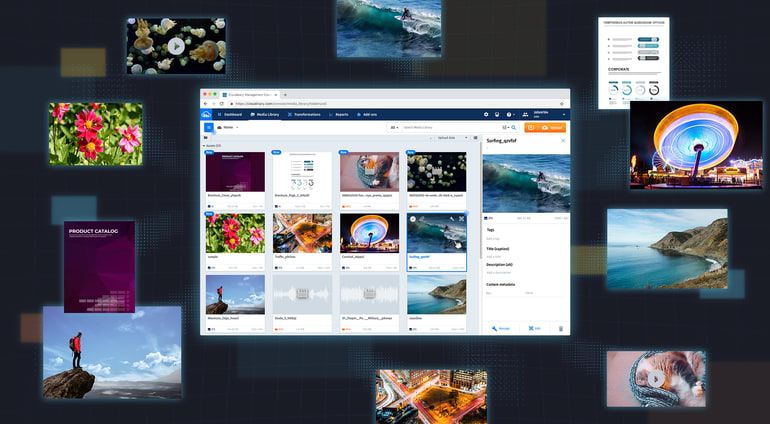Consumers today expect media-rich experiences. No longer a novelty, it’s second nature to swipe through multiple photos on mobile apps, zoom in on product images for a closer look, visualize online travel reviews, socialize cool video clips while browsing, and encounter brand messages when walking into brick-and-mortar stores. These experiences weave together visual cues and clues with relevant content to create meaning and more authentic connections for customers.
Meeting Customer Expectations
Yet while customer expectations are rising, managing digital assets for engaging experiences is hard and getting harder. Consumer brands, retailers, distributors, and manufacturers are struggling to corral the many photos and videos needed to produce media-rich applications, render them correctly on multiple devices, and rapidly update them in a timely and cost-effective fashion. Businesses must contend with the ever-rising volume, variety, and velocity of digital assets.
Adding creative staff to marketing teams is not necessarily the best option for overcoming this rich media tsunami. Manual and disconnected business processes just do not work any more. Needed is a digital asset management (DAM) platform -- a smart repository of record -- for easily storing, organizing, sharing, and distributing rich media on demand and in multiple and web-optimal formats.
A Hub for the Digital Ecosystem
A DAM platform becomes the hub and the single source of truth for managing many thousands and often millions of media assets, including images and videos, across an organization. Consider how a digital retailer relies on a DAM to accelerate business-critical activities.
- Marketers are continually updating photos and video clips displayed on multiple websites and mobile apps. Using their own web content management and marketing automation tools, staffers browse through the shared repository, search by descriptive categories, and select the best digital assets for their campaigns.
- Merchandisers rely on a product information management system to update digital catalogues. They access the same-shared repository and search by product categories to quickly find the images that highlight product features.
There are tangible results. Business teams quickly find the assets they need. They continue to rely on their familiar desktop tools that are seamlessly integrated with the DAM platform through open APIs and microservices. Tasks that once required hours are reduced to minutes. Team members increase their productivity and have the time to launch many more revenue-generating projects.
What a DAM Platform Delivers
A DAM platform simplifies the complexity of rich media distribution. No longer do business teams require technical support when producing images for different devices and screen displays. A DAM automatically manages the digital transformations and bit-rate renderings for smartphones, tablets, PCs, and digital signs, connecting over high-speed wireless and cellular networks. The digital assets adapt and scale to look good on different devices – not stretched, not tiny, but just right.
Moreover a DAM platform expedites image production tasks. Creative professionals have a shared venue for organizing and producing their work. Photo and video editors upload images and share updates during production processes. They can coordinate digital asset reviews, selections, and approvals, saving time by managing these creative activities through the shared repository. When complete they can release the branded assets to the business teams, delivered in their full fidelity, and then monitor how they are being used.
Finally a DAM platform makes it easy to find just the right images within very large collections. Categories are the key -- a DAM platform organizes images by descriptive terms. Certainly digital librarians can continue to tag images during production processes, using predefined taxonomies. But time-consuming manual steps are no longer the only option.
Rather, with ever-increasing precision, a DAM platform automates image tagging in multiple ways. It can:
- Automatically categorize images by the metadata embedded within the assets themselves, including locations, dates, and creative sources.
- Recognize things inside images -- such as faces, landscapes, animals, and colors -- and then automatically tag the assets by their contents.
- Detect scene changes, analyze images, and transcribe audio tracks, enabling automatic tagging within the video stream.
Through machine learning, object identification gets better over time. With automatic tagging and machine-readable descriptions, images become just another set of content types and, like text-oriented documents, can be easily incorporated into line-of-business applications.
Contending with the Rising Tide
In short, a DAM platform brings together multiple elements within the digital ecosystem. Consumer brands, retailers, distributors, and manufacturers can finally deploy the necessary tools needed to produce media-rich experiences. And businesses can cost-effectively contend with the rising tide of digital assets required to meet customer expectations.
Want to Learn More About Digital Asset Management?
- What is Digital Asset Management and Why It Matters for Organizations
- Reimaging DAM: The next-generation solution for marketing & development
- Digital Asset Collaboration be DAM'd
- Adding Structure to Your Asset Metadata
- Share Your DAM Assets!
- Automate Your Media Assets’ Workflow With Machine Learning
- API for extracting semantic image data - colors, faces, Exif data and more
- The Evolution of Digital Asset Management Systems: On-Premise, Cloud, Dynamic
- Media Asset Management and Enterprise Content Management: What’s the Difference?
- Digital Asset Managers: What They Do and Why You Need One
- Digital Asset Management Software: A Buyer’s Guide
- DAM Best Practices and Critical Success Factors
- A unified approach to DAM across the asset lifecycle
- How a cloud-native DAM optimizes customer experiences
- Don’t let your digital assets become a liability!





